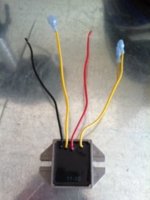Hi guys I was hoping someone out there would be able to help me out. I just finished my 1977 XS360 project and have discovered that my battery is not charging.
I have gone through all the tests in the service manual and as far as I can tell I have a bad regulator and a bad rectifier.
I went ahead and picked up an aftermarket regulator/rectifier combo unit but it came without any instructions and I have no idea how to wire this thing up. Hopefully one of you wiring wizards out there can explain to me what needs to be done. I am including a picture of the new unit so you can see what I am dealing with.
According to the ohm meter readings I also have a bad alternator. I cant hardly believe that I would be unlucky enough to have every component of the charging system be bad. The manual says the alternator resistance readings sould be 0.76 and the readings I was getting were 1.8 ohms. Does anyone know if an alternator can be fixed or are there new aftermarket alternators avaliable?
Any help would be greatly appreciated! Thanks
I have gone through all the tests in the service manual and as far as I can tell I have a bad regulator and a bad rectifier.
I went ahead and picked up an aftermarket regulator/rectifier combo unit but it came without any instructions and I have no idea how to wire this thing up. Hopefully one of you wiring wizards out there can explain to me what needs to be done. I am including a picture of the new unit so you can see what I am dealing with.
According to the ohm meter readings I also have a bad alternator. I cant hardly believe that I would be unlucky enough to have every component of the charging system be bad. The manual says the alternator resistance readings sould be 0.76 and the readings I was getting were 1.8 ohms. Does anyone know if an alternator can be fixed or are there new aftermarket alternators avaliable?
Any help would be greatly appreciated! Thanks


